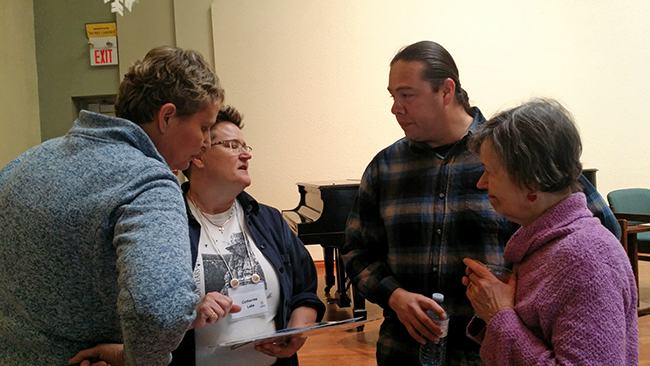King exhibit open until Feb. 28

By Barb Nahwegahbow
TORONTO — “As an artist, I’m never short of ideas,” artist Clayton Samuel King told people gathered for the opening of his exhibition at First Unitarian Church in Toronto on February 7. “Every day, I look at Creation, life, people and draw my inspiration from that.” King spoke about the many Indigenous artists who have inspired him including Arthur Shilling, Norman Knott, Alex Janvier and Leland Bell. Woodland artist Carl Rae who passed away a month before King’s birth has been a special inspiration, he said.
King’s work is all about honouring Creation and the ancestors. This talented multi-media artist from Beausoleil First Nation is a graduate of Fanshawe College in London. He graduated in 2010 with a Fine Art Advanced Diploma. Although he works primarily with acrylic paints, he also works with other mediums including photography, sculpture, graphite and traditional First Nations crafts. King travels the Pow Wow trail where he’s well-known as a Northern Traditional Dancer.
In his artist’s talk at the opening, King proved himself to be just as skilled at oral storytelling as he is at visual storytelling. He is able to weave together traditional teachings, his family history and the inspiration for particular pieces into a compelling narrative. It enabled his audience to not only appreciate the rich cultural history and traditions of the Anishinabek people as depicted in his paintings, but also to learn about the disruptions and losses caused by colonization. His engaging style with his audience creates a safe environment for people to ask questions to not only further their understanding of his work, but also of Anishnawbe culture and history.
Kate Cottingham, Chair of the Arts Committee at First Unitarian Church, described King as, “a knowledgeable and generous teacher.” She first saw his work at Toronto’s John B. Aird Gallery in January 2014, and again at the same gallery in June 2014. His work in both shows won very high praise, she said.
Many of the paintings in the exhibition have the Thunderbird Spirit as the main subject, “the ones that help to guide our life in a good way,” he said. Most people, said King, don’t realize that the Thunderbird has 50 or 60 different names, most of which have been lost. King has been working with Elders across the Anishinabek Nation in a bid to retrieve those names and teachings that have been lost. The paintings convey the Thunderbird’s power, their role, and their connectedness to our world.
Wassabmosakwe (Walks Far Woman) is a painting that King did in 2015 in honour of his late mother. It depicts a woman carrying an Eagle Feather in one hand and a copper pail in the other and walking towards a starblanket. His mother’s spirit name was Wassabmosakwe, King said, and even though she has passed into the spirit world, her memory lives on in him and the way he thinks and looks at the world. He also wanted, “to honour those women warriors who are fighting to keep our waters clean, the Great Lakes. They’ve been raising attention to pollution and all the harm that’s happened throughout history to these waters, the largest freshwater system in the world. It’s our responsibility to protect it,” he said.
“I was thrilled when Clayton agreed to exhibit his work at First Unitarian, said Kate Cottingham, “because he has mastered his craft.” She went on to say that First Unitarian wants to be part of the reconciliation process. “Central to Clayton’s work are the Seven Grandfather Teachings – wisdom, love, respect, bravery, honesty, humility and truth. These teachings are helpful reminders for us going forward,” she said.
Indigenous artists interested in exhibiting at First Unitarian are invited to contact Cottingham at: arts@firstunitariantoronto.org.
The exhibition of Clayton King’s work is open until February 28. First Unitarian is located at Avenue Road and St. Clair. For opening hours, call 416-924-9654. King’s art can also be viewed on his website: www.whitebearart.com.


